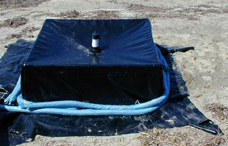
Caulerpa taxfolia Eradication Using Herbicide Chlorine Solution

This diagram shows the natural species to the altered male algae
Marine Biologist Team : Bonnie Monahan, Kathleen Potter and Shannon Myer from MiraCosta College in Oceanside, California
Caulerpa taxifolia Background: Caulerpa taxifolia is green alga that typically grows in patches of tropical or subtropical waters. First identified in the Mediterranean Sea, Caulerpa taxifolia is believed to have come from a local Monaco aquarium and let loose in the open ocean. The natural C. taxifolia had genetically altered to form a male hybrid able to clone itself. Killing this algae was not attempted until it was too late, and as a result the entire Mediterranean Sea was wiped out productively from the natural ecosystem by smothering and killing all animal and plant life. This new C. taxifolia can grow more than nine feet long with up to 200 fronds per stem. It spreads through fragmentation. It can survive up to ten days out of water. It can grow and colonize on rocks, mud and sand from the beach shore to a depth of 150 feet at a growth rate from one to two inches a day. It can tolerate temperatures of 50 degrees for a few months. It secretes a toxin that mollusks, herbivorous fish and sea urchins avoid. Caulerpa taxifolia now encroaches upon Australia, Italy, Spain, France, Monaco and Southern California.
Caulerpa taxifolia was chosen because of its invasion of the Carlsbad Agua Hedionda Lagoon right here in San Diego County, as well as the Huntington Harbor in Orange County, California. Much is being done world wide to prevent a repeat of the Mediterranean Sea outbreak. However, all attempts for a quick means to kill this algae have failed. Public awareness is vital, by educating the population about the danger of Caulerpa taxifolia; hopefully it will encourage them to report any findings to the proper authorities. As well as raise awareness to have stricter guidelines for foreign ships coming to port in the United States to look for transportation of the algae on the hull of vessels and their anchors.
|
Photo taken by Alex Meinesz in the Mediterranean Sea. |
 Another photo by Alex Meinesz in the Mediterranean Sea. |
|
|
 |
 |
Equipment Needed: (3) Patches of healthy Caulerpa taxifolia in three different salinity locations of the Agua Hedionda Lagoon, all patches to include one foot of growth with holdfast and rhizoids included. (3) Frames made of Schedule 40 PVC ½ inch diameter, frames to be 5’ x 15’. (3) Heavy duty plastic tarps. (100) kg white sand, or gravel bags. (10) Liters 15% chlorine diluted to 5% (USP). (1) Chlorine dilution tank. (800) Feet ¼ inch diameter rubber lined PVC hose. (15) ½ inch PVC couplers, PVC glue. (1) Sewerage 1 HP electric pump with ½ inch valves, for all contained areas. (3) 12” round hardened rubber disks. (6) 1” PVC pipes. (3) Ultra fine sturdy mesh screens 3” in diameter. (2) Temperature controlled laboratory storage cabinets with lighting. (2) Boats for divers.
|
Small patch of Caulerpa taxifolia |
 Covered tarp |
Study Approach: (a) Place schedule 40 PVC framed tarps over patches of healthy Caulerpa taxifolia going 8” under the mud. (b) Place hardened rubber disks under the tarps. (c) Put schedule 40 PVC pipe in the center of hardened disk to go above all expected water heights. (d) Weight down the frames with the sand or gravel bags. (e) Seal all edges of the tarp. (f) Cut vent hole in top of each tarp, seal disk center opening and add ultra fine mesh on top of pipe exposed through cut out hole. This vented opening allows gas to escape but not algae. (g) Inject covered and sealed frames with the 5% chlorine solution until the chlorine residual is detected inside the enclosed area for 48 hours. (h) Monitor inside the tarp after 14 days to see if it is dead. (i) Examine around the tarp area four weeks for new growth.
Hypothesis: The 5% chlorine solution administered over a 48-hour period will kill the Caulerpa taxifolia from the Agua Hedionda lagoon.
Results for the chlorine method of killing C.
taxifolia:
-
Chlorine solution is the best way to kill this algae
-
Kills rather than just slowing down the growth process
-
Future fragments are killed so there is no new growth
-
The chlorine treatment will not endanger sea life
Results to refute the chlorine method of killing
C. taxifolia:
-
Aquatic life trapped in the tarp will die fast from the chlorine
-
No photosynthesis after 48 hours in the tarp will kill it, therefore chlorine is not needed

Agua Hedionda storm drain could be another source of this algae in the lagoon
 You can contact Bonnie Monahan at:
BonnieWMon@aol.com
You can contact Bonnie Monahan at:
BonnieWMon@aol.com
You can contact Kathleen Potter at: kathleenmahan@cs.com
You can contact Shannon Myer at: ksmyer1121@aol.com
Southern California Action Team telephone number is: (858) 467-2985
CA Regional Water Quality Board telephone number is: (858) 467-2952
CA Department of Fish and Game telephone number (South Coast Region) is: (562) 980-4043
